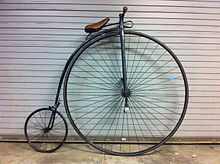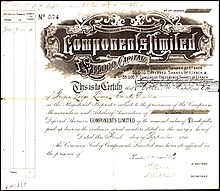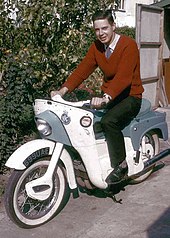 | |
| Industry | Manufacturing and engineering |
|---|---|
| Founded | 1902 |
| Defunct | 1970 |
| Fate | Sold to BSA and discontinued |
| Successor | BSA |
| Headquarters | Bournbrook, Birmingham |
Key people | Jack Sangster, Edward Turner and Val Page |
| Products | motorcycles |
Ariel Motorcycles was a British maker of bicycles and then motorcycles in Bournbrook, Birmingham. It was an innovator in British motorcycling, part of the Ariel marque. The company was sold to BSA in 1951 but the brand survived until 1967. Influential Ariel designers included Val Page and Edward Turner. The last motorcycle-type vehicle to carry the Ariel name was a short-lived three-wheel tilting moped in 1970.
Ariel made bicycles before making motorcycles, and also made cars. Car production began in 1902, moved to Coventry in 1911 and ceased in 1925.
The 'Ariel' name was reused in 1999 for the formation of Ariel Ltd, a sports car producer.
History
Bicycles and early motorised vehicles


The original company was established in 1870 by James Starley and William Hillman. They built wire-spoke wheels under the first British patent; this allowed them also to build a lighter " penny farthing" bicycle which they named 'Ariel' (the spirit of the air). [1] [2] [3] They put the name on the factory where they made penny-farthing bicycles and sewing machines. In 1885 James Starley's nephew, John Kemp Starley, invented the Rover Safety Bicycle - a bicycle with similarly sized wheels and chain drive to the rear wheel, the design used on bicycles today.
Ariel merged with Westwood Manufacturing in 1896 and made a powered tricycle in 1898 with a 2.25 hp de Dion. [3] Hillman left soon afterwards to found Premier Motorcycles. [4] [5] More tricycles were produced and motorised quadricycles were added in 1901 as Ariel moved into car production. (See also List of motorized trikes and/or Quadricycle)
Components Ltd.


In 1902, Ariel produced its first motorcycle, which had a Kerry engine [6] with a magneto ignition and a float carburettor.[ citation needed] That year, Ariel was taken over by Components Ltd, owned by Charles Sangster. [7] Sangster built a three-speed, two-stroke motorcycle sold as the "Arielette", but he stopped production on the outbreak of the first world war. [3]
In 1918, Sangster's son Jack began managing the Ariel division of Components Ltd and developed a successful motorcycle with a 4 hp White and Poppe engine. Jack increased the range of motorcycles to include 586 cc and 992 cc machines. A range of motorcycles was made until 1926 with engines bought in or assembled to others' designs, until a new designer, Val Page, joined Ariel from JAP. That year Page created a pair of new engines which used many existing motorcycle parts, then redesigned the motorcycle for 1927. These new models are known as Black Ariels (1926–1930) and were the basis on which all Ariel four-stroke singles were based until their demise in 1959 (except the LH Colt of the mid-1950s). During the Black Ariel period, the Ariel horse logo came into being, as did the slogan 'The Modern Motor Cycle'.
Ariel Motors

Components Ltd. suffered several financial crises including spells in receivership in 1911 and in the early 1930s. In 1932, Components Ltd went bankrupt, and Jack Sangster, Charles Sangster's son, bought the Ariel subsidiary from the receivers at a bargain price. The company was renamed Ariel Motors (J.S.) Ltd, and promptly resumed production. [1] A new factory was set up at Selly Oak in Birmingham. One of their first bikes was the Ariel Square Four, designed by Edward Turner, followed by the Ariel Red Hunter. [2] The Red Hunter was a success, and enabled Ariel to purchase Triumph. [8]

The Ariel Square Four with a 500 cc engine designed by Edward Turner first appeared for the 1931 season. Around this time the company went into receivership and then a new company was formed. The Square Four displacement was increased to 600cc. Throughout their history, the Square Fours had overheating problems with the rear cylinders which resulted in distorted heads. A redesign in 1937 [9] resulted in a 995 cc OHV version designated the 4G. [10]
In 1939, Anstey-link plunger rear suspension was an option. It was still available when production restarted in 1946, with telescopic forks replacing the girder forks.
During the Second World War, the Ariel factory was turned over to military production, including the Ariel W/NG 350 army motorcycle based on the civilian NG model but with higher ground clearance frame inspired by that used successfully by Fred Povey in the ISDT. [2]
In 1949, the Mark 1 Square Four engine was revised to include a cast aluminium cylinder block and head in place of the cast iron components previously used, in an effort to promote cooling. With the lower weight the bike was a 90 mph (140 km/h) plus machine.
BSA
In 1951, Jack Sangster sold Ariel and Triumph (bought in 1936) to the Birmingham Small Arms Company group (BSA) and joined their board. Ariel began making the 500 cc KH model and the 650 cc Huntmaster, which had an engine based on the BSA A10 parallel twin. Reliable and capable of 100 miles per hour (160 km/h), the Huntmaster proved popular with sidecar enthusiasts. [11] [12]
By 1956, Sangster was voted in as the new Chairman, defeating incumbent Sir Bernard Docker 6 to 3. Sangster promptly made Edward Turner head of the automotive division, which then included Ariel, Triumph, and BSA motorcycles, as well as Daimler and Carbodies (the manufacturer of London Taxicabs). [13]
In 1953, the Mark 2 Square Four had a redesigned cylinder head, and was capable of 100 mph (160 km/h).
The Red Hunter formed the basis for Sammy Miller's 1955 trials motorcycle which proved very successful in competition. [11]
Two-strokes and demise


In 1959, Ariel dropped its four-stroke engines and produced the Ariel Leader, a fully enclosed 250 cc two-stroke with a fully faired body from the headlamp aft. The Leader aimed to combine the benefits of the motorcycle with the advantages of a scooter. Ariel also made the Arrow, a more open version of the Leader which kept the Leader's enclosed chain case and deep mudguards. Both models were an unsuccessful attempt to compete with new Japanese imports.
BSA closed the Ariel factory at Selly Oak in 1962 and moved production of the Leader and the Arrow to the BSA factory at Small Heath. [7] Production of the 50 cc Pixie began in 1963. [14]
In 1965, Ariel produced its last motorcycle, the Arrow 200 with capacity reduced to 200 cc introduced earlier during 1964 to qualify for lower UK rider insurance. [15] Ariel motorcycles ceased production in 1967. [3]
Later use of the Ariel name
In 1970, parent company BSA produced the Ariel 3, a 49 cc automatic tricycle with a coupling between the front and rear frame sections allowing banking when cornering. [3] The front half was hinged to the rear and could tilt into corners while keeping all three wheels on the ground. The design was licensed from George Wallis, of G.L.Wallis & Son, who had patented it in 1966. A small museum dedicated to the trike has been established in Bristol, England. [16]
Following the failure of the Ariel 3, the design was licensed to Honda which produced it as the Honda Gyro.
In 1999 a new company was formed using the old 'Ariel' name. Initially, the Ariel Motor Company made only one model, the Atom, a high performance, minimalistic 2-seat road-legal sports car, followed by a large-capacity motorcycle named Ariel Ace. [17]
Gallery
-
1931 Ariel M2F 350 cc
-
1932 Ariel Red Hunter
-
Ariel Golden Arrow
-
Ariel and Triumph dealer in Texas, ca. 1930-1945
-
Leader with optional panniers and indicators
-
2014 Ariel Ace
Famous models
- Models A - G [18] [19]
- VCH
- KHA
- Cyclone (model owned by Buddy Holly)
- Trials HT5
- Trials HT3
- Scrambles HS (Mk1,11,111)
Cars

Cars were produced over two periods: from 1902 to 1915, and again from 1922 to 1925. The first proper Ariel car was a 10 hp (7.5 kW) twin-cylinder car produced in 1902. [20] In 1903 its first four-cylinder was a 15/19 model. [20] [note 1] Both these vehicles had a leather cone clutch that was entirely separate from the flywheel.[ citation needed] In 1904 the 15HP car had the distinction of being the first motor car to ascend Snowdon, albeit using the mountain railway trackbed which has long stretches of 1 in 5 gradient. [21] In early 1904, Ariel began production of a six-cylinder model [22] built on a seemingly inadequate tubular steel chassis.[ citation needed]
An entirely new range was announced at the end of 1905; called the 'Ariel-Simplex', these cars were Mercedes-inspired four-cylinder designs [22] of 15 hp and 25/30 hp and a six of 35/40 hp.[ citation needed] In 1907–1908 the company began production of their 50/60 hp six, which offered a 15.9-litre engine [22] for a chassis price of £950.[ citation needed] In 1907 Ariel sold its Birmingham factory to the French Lorraine-Dietrich company, who wanted to enter the British market; Ariel cars were thereafter assembled at the Coventry Ordnance Works, a branch of Cammell Laird. [23] The arrangement with Lorraine-Dietrich was cancelled in 1910.[ citation needed] Production of a 1.3-litre light car ended with the outbreak of World War I.[ citation needed]
Ariel resumed making motor cars in 1922 [22] when it launched the Ariel Nine light car. The Nine had a 997 cc water-cooled side-valve flat twin engine with "square" dimensions of 85 mm bore and 85 mm stroke made by A Harper Sons & Bean, Ltd of Dudley. The Nine was designed by Jack Sangster, the son of Ariel's owner, who had designed the similar, but air-cooled, twin-cylinder Rover 8 when he worked for Rover. [24]
The Nine was capable of 55 mph (89 km/h) and about 700 were made.[ citation needed] However, the engine was vibratory and noisy, so in 1924 Ariel discontinued the model and replaced it with the 10 hp (RAC) car. [22] [note 2]
The "Ten" had a 1097 cc four-cylinder Q-Type engine [25] made by the Swift Motor Company. Unlike the Nine it was a long-stroke engine, with a bore of only 60 mm and stroke of 97 mm. [24] The Ten had a gearbox combined with the rear axle.[ citation needed] The car was advertised at £180 for the chassis, and about 250 were made.[ citation needed] In 1925 Ariel discontinued car production to concentrate on motorcycles. [25]
See also
Notes
- ^ "15/19" meant 15 RAC horsepower, about 19 horsepower (14 kW) actually being delivered
- ^ By this time, RAC horsepower was a tax formula and was unrelated to the output of the engine.
References
- Citations
- ^ a b Roberts, Glenn. "Supershow Collection: Admirable Characters". SuperShowEvents.com. Archived from the original on 27 September 2013. Retrieved 29 December 2006.
- ^ a b c De Cet, Mirco (2005). Daniel, Quentin (ed.). The Complete Encyclopedia of Classic Motorcycles. Rebo International. ISBN 978-90-366-1497-9.
- ^
a
b
c
d
e Chadwick, Ian, ed. (6 June 2003).
"British Motorcycle Manufacturers – A". British Motorcycle Manufacturers.
Archived from the original on 11 June 2008. Retrieved 15 August 2008.
Founded by James Starley and William Hillman in 1870 to make bicycles and the first patented tensioned wire-spoke wheel...
- ^ "Premier". Archived from the original on 26 September 2008. Retrieved 2008-08-25.
- ^ Chadwick, Ian, ed. (6 June 2003). "British Motorcycle Manufacturers – P". British Motorcycle Manufacturers. Archived from the original on 29 May 2008. Retrieved 15 August 2008.
- ^ Tragatsch, Erwin (1985). Illustrated History of Motorcycles. Book Sales. p. 15. ISBN 0906286077. Retrieved 14 April 2014.
- ^ a b Tragatsch, Erwin (1964). The World's Motorcycles, 1894–1963. Temple Press Books. p. 11. Retrieved 21 April 2014.
- ^ Salvadori, Clement (8 November 2011). "Retrospective: Ariel Red Hunter 500cc: 1932 – 1959". Rider Magazine. Archived from the original on 11 July 2012. Retrieved 2 August 2012.
- ^ "1937 Ariel Red Hunter NH 350". 28 September 2011. Archived from the original on 28 September 2011. Retrieved 24 July 2018.
- ^ "Square Four". Practical Classics. Retrieved 13 October 2006.
- ^ a b Brown, Roland (2002). Classic Motorcycles. Anness Publishing. pp. ?. ISBN 1-84038-433-6.
- ^ Reynolds, Jim (1990). Best of British bikes. Patrick Stephens. p. 31. ISBN 1-8526-0033-0. Retrieved 21 April 2014.
- ^ Buckley, Martin (May 1999). "Daimler's Queen of Excess". Thoroughbred & Classic Cars. Peterborough: EMAP Automotive Ltd: 103–106. ISSN 0143-7267.
- ^ Bonhams Lot 387 c.1965 Ariel 49cc Pixie Engine no. P886
-
^ "Ariel models for 1965 season".
Earls Court Show Guide.
The Motor Cycle. 19 November 1964. p. 850.
...the relatively new Arrow 200...Reduced insurance premiums, for only slightly less performance; that's the Arrow 200 claim.
- ^ "The Ariel 3 Museum". Retrieved 10 September 2014.
- ^ "ARIEL". Ariel Motor Company. 2017. Retrieved 3 April 2017.
- ^ "1926 Ariel - Model D - Touring - 500". 28 September 2011. Archived from the original on 28 September 2011. Retrieved 24 July 2018.
- ^ "Ariel 1930 Model G". 28 September 2011. Archived from the original on 28 September 2011. Retrieved 24 July 2018.
- ^ a b Culshaw & Horrobin, The Complete Catalogue of British Cars 1895–1975, p. 44
- ^ Climbing Snowdon by Motor Car, The Automotor Journal, 4 Jun 1904, p687
- ^ a b c d e Culshaw & Horrobin, The Complete Catalogue of British Cars 1895–1975, p. 45
- ^ Kimberley, Damien (2012). Coventry's Motorcar Heritage. Brimscombe Port: The History Press. ISBN 978-0-7524-9041-0. Retrieved 14 April 2013.
- ^ a b Hartley, Peter (1980). The Ariel Story. Watford: Argus Books. pp. 64–65. ISBN 0-85242-681-X.
- ^ a b Culshaw & Horrobin, The Complete Catalogue of British Cars 1895–1975, p. 46
- Sources
- Culshaw, David; Horrobin, Peter (2013) [1974]. "Ariel: Ariel-Simplex". The Complete Catalogue of British Cars 1895–1975 (e-book ed.). Poundbury: Veloce Publishing. pp. 44–46. ISBN 978-1-845845-83-4.
External links
This section's use of
external links may not follow Wikipedia's policies or guidelines. (September 2017) |
- Ariel Owners Motor Cycle Club
- Jeremy Mortimore's site on Ariel Cycles
- The Ariel Motorcycle Club of North America (also includes a series of sections on the history of Ariel motorcycles)
- Outline history of Ariel Motorcycles on Ian Chadwick's British Motorcycle Manufactures web pages
- A short history of Ariel Motorcycles up to 1910 on Leon Mitchell’s website
- Photo of 1924 Ariel Nine Four Seat Tourer
- 1923 Ariel Nine Four Seat Tourer advertisement
- Defunct motorcycle manufacturers of the United Kingdom
- Defunct cycle manufacturers of the United Kingdom
- Defunct companies based in Birmingham, West Midlands
- Manufacturing companies established in 1870
- Vehicle manufacturing companies established in 1902
- Vehicle manufacturing companies disestablished in 1970
- Veteran vehicles





